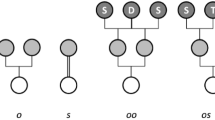Summary
The purpose of this article was to extend the model used to predict selection response with selfed progeny from 2 alleles per locus to a model which is general for number and frequency of alleles at loci. To accomplish this, 4 areas had to be dealt with: 1) simplification of the derivation and calculation of the condensed coefficients of identity; 2) presentation of the genetic variances expressed among and within selfed progenies as linear function of 5 population parameters; 3) presentation of selection response equations for selfed progenies as functions of these 5 population parameters; and 4) to identify a set of progeny to evaluate, such that one might be able to estimate these 5 population parameters.
The five population parameters used in predicting gains were the additive genetic variance, the dominance variance, the covariance of additive and homozygous dominance deviations, the variance of the homozygous dominance deviations and a squared inbreeding depression term.
Similar content being viewed by others
References
Chevalet C, Gillois M (1977) In: Pollak E, Kempthorne O, Bailey TB Jr (eds): Proc Int Conf Quant Genet. Iowa State University Press, Ames, Iowa
Cockerham CC (1969) Notes on quantitative genetics. North Carolina State University, Raleigh NC
Cockerham CC (1983) Covariances of relatives from self-fertilization. Crop Sci 23:1177–1180
Cockerham CC, Matzinger DF (1985) Selection response based on selfed progenies. Crop Sci 25:483–488
Cowen NM, Weber GP, Frey KJ (1985) BASIC programs for estimating coefficients of inbreeding, parentage, and identity. J Hered 76:401
Gillois M (1964) La relation d'identité génétique. Thesis, Faculté des Sciences, Paris
Hailauer AR, Miranda JB (1981) Quantitative genetics in maize breeding. Iowa State University Press, Ames, Iowa
Harris DL (1964) Genotypic covariance between inbred relatives. Genetics 50:1319–1348
Horner TW, Weber CR (1956) Theoretical and experimental study of self-fertilized populations. Biometrics 12:404–414
Jacquard A (1974) The genetic structure of populations (transl by Charlesworth D and Charlesworth B). Springer, Berlin Heidelberg New York
Kempthorne O (1969) An introduction to genetic statistics. Iowa State University Press, Ames, Iowa
Nyquist WE (1978) Notes on statistical genetics. Purdue University, West Lafayette Ind
Sprague GF (1966) Quantitative genetics in plant improvement. In: (ed) Frey KJ: Plant breeding. Iowa State University Press, Ames, Iowa, pp 5–10
Weir BS, Cockerham CC (1977) Two-locus theory in quantitative genetics. In: Pollak E, Kempthorne O, Bailey TB Jr (eds): Proc Int Conf Quant Genet. Iowa State University Press, Ames, Iowa, pp 247–269
Author information
Authors and Affiliations
Additional information
Contribution from the Missouri Agricultural Experiment Station. Journal Series No. 9971
Rights and permissions
About this article
Cite this article
Cowen, N.M. Selection theory for selfed progenies. Theoret. Appl. Genetics 73, 182–189 (1986). https://doi.org/10.1007/BF00289273
Received:
Accepted:
Issue Date:
DOI: https://doi.org/10.1007/BF00289273




